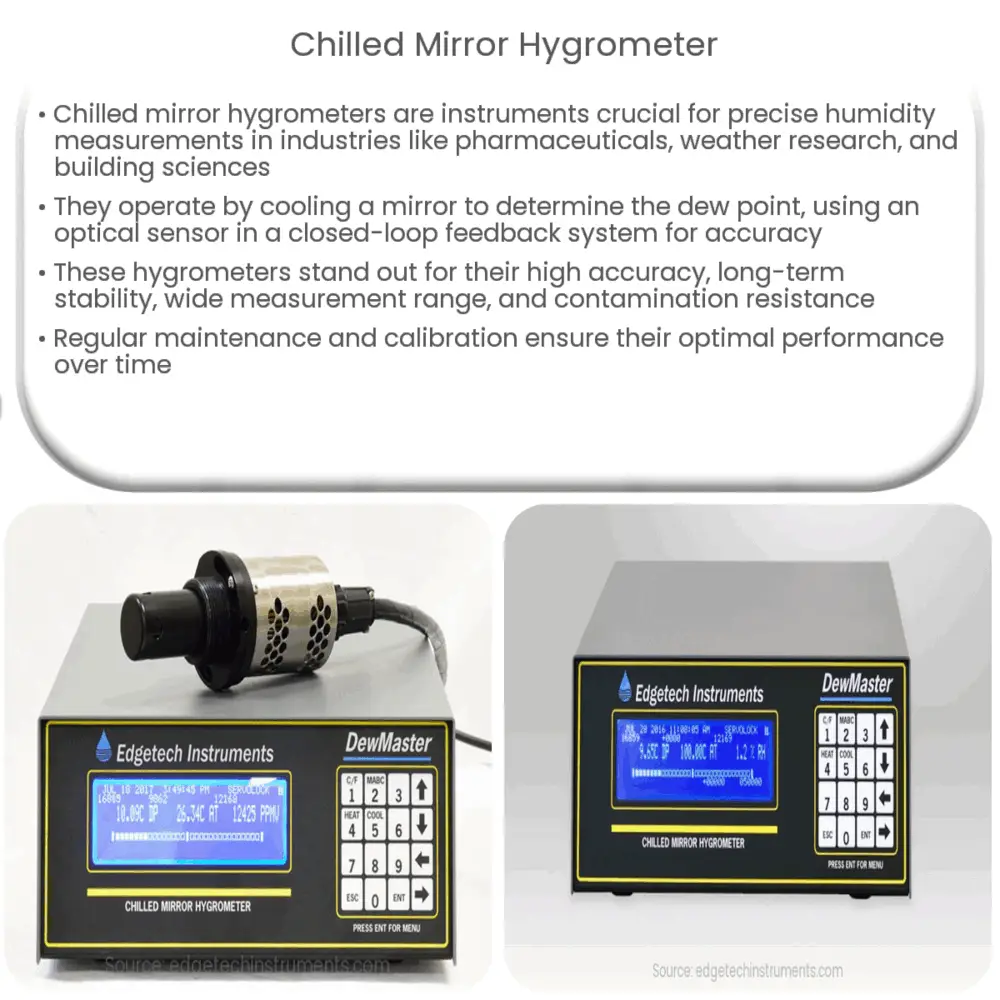A chilled mirror hygrometer is a precise instrument for measuring humidity, widely used in industries like meteorology, manufacturing, and building science.

Understanding Chilled Mirror Hygrometers: Principle, Applications, and Benefits
Introduction
A chilled mirror hygrometer is an essential instrument for measuring humidity in a variety of applications, from industrial processes to atmospheric research. By employing a unique and highly accurate method to determine the dew point or frost point temperature, chilled mirror hygrometers offer unparalleled reliability and precision. In this article, we will explore the underlying principle of chilled mirror hygrometers, their practical applications, and the benefits they bring to various industries.
Principle of Operation
The fundamental principle behind a chilled mirror hygrometer is the dew point, which is the temperature at which water vapor in the air starts to condense into liquid water. A chilled mirror hygrometer measures this dew point or frost point temperature by cooling a reflective surface (the mirror) and monitoring the point at which condensation forms on it. The temperature of the mirror at this point is a direct measurement of the dew point temperature.
To ensure accurate measurements, the chilled mirror hygrometer employs a closed-loop feedback system. An optical sensor, typically a photodetector, constantly monitors the mirror’s surface for any changes in reflectivity caused by condensation. When the sensor detects a change, it sends a signal to a control unit that adjusts the mirror’s temperature to maintain a constant level of condensation. This closed-loop system ensures that the hygrometer continuously provides an accurate dew point measurement.
Applications
Chilled mirror hygrometers are used in various industries and settings, thanks to their high precision and reliability. Some of the most common applications include:
- Industrial processes: Humidity control is crucial in many industrial processes, such as pharmaceutical manufacturing, semiconductor fabrication, and food processing. Chilled mirror hygrometers help maintain the required humidity levels, ensuring product quality and minimizing waste.
- Meteorological and atmospheric research: Accurate humidity measurements are essential for understanding weather patterns and climate change. Chilled mirror hygrometers are often used in weather stations and research facilities to provide precise data on atmospheric conditions.
- Environmental testing: Chilled mirror hygrometers are commonly used to simulate various environmental conditions in test chambers. These tests help assess the performance and durability of products under different humidity levels and temperature conditions.
- Building science: By measuring the dew point, chilled mirror hygrometers help assess the potential for condensation and mold growth in buildings, contributing to a healthier indoor environment.
Benefits of Chilled Mirror Hygrometers
There are several advantages to using chilled mirror hygrometers, which make them a popular choice in various industries. Some of the key benefits include:
- High accuracy and precision: Chilled mirror hygrometers offer exceptional accuracy and repeatability, making them ideal for applications that require precise humidity measurements. This accuracy is mainly due to their direct measurement of the dew point temperature, rather than relying on secondary variables like capacitance or resistance changes.
- Long-term stability: Unlike some other types of hygrometers, chilled mirror hygrometers do not exhibit significant drift over time. This means that they can maintain their accuracy for extended periods, reducing the need for frequent recalibration.
- Wide measurement range: Chilled mirror hygrometers can measure a broad range of dew point temperatures, from as low as -100°C to over +100°C, making them suitable for a variety of applications.
- Resistance to contamination: The optical sensor used in chilled mirror hygrometers is less prone to contamination than other sensing elements, ensuring accurate measurements even in harsh environments.
Maintenance and Calibration
Although chilled mirror hygrometers are known for their long-term stability, it is essential to perform regular maintenance and calibration to ensure their ongoing performance. Key maintenance tasks include cleaning the mirror surface to remove any contaminants and checking the optical sensor for proper alignment and function.
Calibration is typically done using a reference humidity generator, which provides a known humidity level for comparison. It is important to calibrate the hygrometer across its entire operating range to ensure accurate measurements under all conditions. Some manufacturers offer calibration services or provide guidelines for performing calibration in-house.
Conclusion
Chilled mirror hygrometers are a reliable and accurate choice for measuring humidity in various applications, from industrial processes to atmospheric research. Their ability to provide direct dew point temperature measurements, combined with their high precision, long-term stability, and resistance to contamination, makes them an invaluable tool for ensuring optimal humidity control and monitoring. Regular maintenance and calibration are crucial to maintaining their performance, ensuring that they continue to deliver accurate and reliable measurements for years to come.

